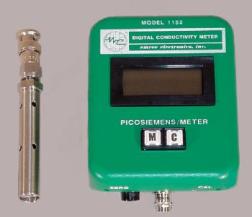Continuous standard electrical conductivity range from 1 to 2000 in increments of 1 picosiemen per meter (pS/m)
Available in other standard and non-standard conductivity ranges up to 20M pS/m
Large digital, liquid crystal display
Reliable advanced integrated circuit design technology
Self check calibration with field adjustment capability
Automatic over range and low battery indication
Capable of storage tank and tanker truck measurement with the use of a short cable or cable reel kit
Powered by 3 readily available alkaline batteries
Electronics housed in a rugged cast aluminum case coated with solvent resistant paint equipped with a detachable stainless steel probe
Approved intrinsically safe design for use in hazardous environments by Underwriters Laboratories (UL) U.S, (UL) Canada and LCIE (Europe)
Applications:
The Model 1152 Digital Conductivity meter provides a measurement of electrical conductivity of fluids in conductivity units (CU), which are defined as picosiemens per meter in ASTM D2624. The rugged Electro/mechanical design of the Model 1152 meter facilitates ease of use for both laboratory and field applications. Initially the meter was designed and developed for safety reasons to measure the electrical conductivity of hydrocarbon fuels, particularly jet fuels. Subsequently, the meter was modified with other conductivity ranges to accommodate measurement of a variety of fluids for use in many different applications.
Safety:
Hydrocarbon fuels typically have low electrical conductivity and consequently are susceptible to retaining a static charge. Static charges are induced, especially, when the fuel is pumped at high rates through filters. Due to the relatively low conductivity, the static charge does not readily dissipate and is retained for a considerable period of time. This condition can result in an explosion and/or fire. Since conductivity can vary with temperature it is important to record the fuel temperature at which the measurement was performed.
Process Controls:
In addition to safety reasons, electrical conductivity of fluids can be monitored for process control. Proper addition and mixing of various ingredients can be monitored at different stages of production. These applications are not limited to hydrocarbons, but have been expanded to other products; such as paints, solvents, inks, and other non-organic items. The stainless steel probe is relatively unaffected by most acidic and caustic solutions.
Digital EMCEE Conductivity Meter

